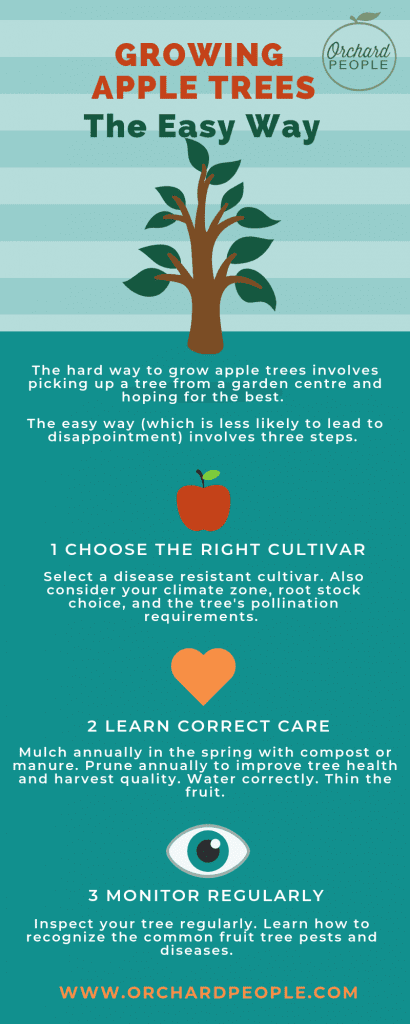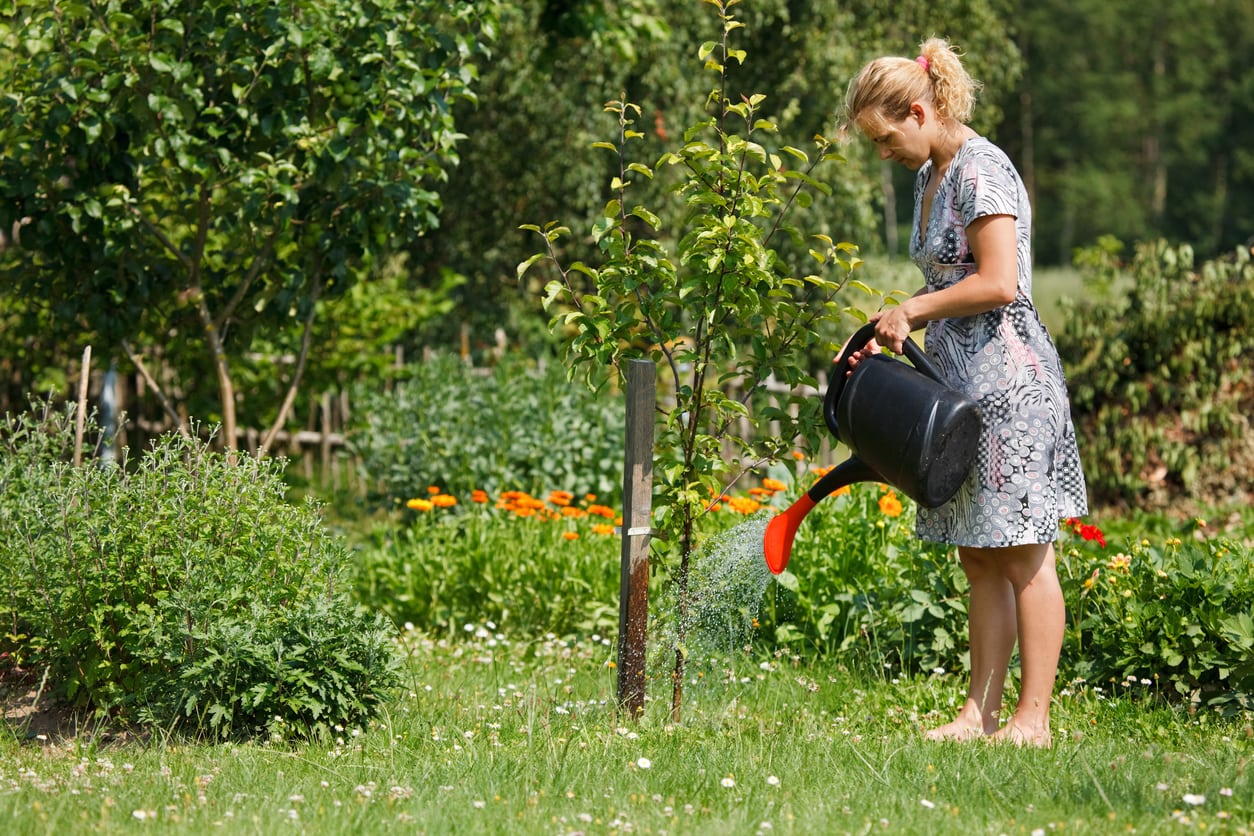Water apple trees deeply once every 7-10 days, adjusting based on weather conditions. Proper watering is essential for apple tree health and fruit production.
Apple trees require consistent moisture to thrive and produce quality fruit. Incorrect watering practices can lead to issues such as root rot, poor fruit set, and overall tree decline. By understanding the watering needs of apple trees and monitoring moisture levels in the soil, you can ensure your apple trees remain healthy and productive.
Proper watering practices are key to maintaining a successful apple orchard and enjoying a bountiful harvest each season.

Credit: www.mehrabyannursery.com
1. Factors Affecting Watering Frequency
1. Factors Affecting Watering Frequency
1.1 Soil Type
The type of soil in which apple trees are planted plays a crucial role in determining the frequency of watering. Soil that retains water for a longer period will necessitate less frequent watering compared to well-draining soil. Clay soil tends to hold moisture for longer, requiring less frequent watering, while sandy soil drains quickly, necessitating more frequent watering.
1.2 Tree Age
The age of the apple tree is a key factor in determining how often it should be watered. Young apple trees, particularly those in the first three years of growth, require more frequent watering as their root systems are still developing. Mature apple trees, on the other hand, require less frequent watering as their extensive root systems can access water from a larger area.
1.3 Weather Conditions
Weather conditions have a significant impact on the watering frequency of apple trees. During hot and dry periods, trees will require more frequent watering to maintain their moisture levels. Conversely, during periods of heavy rainfall, the frequency of watering will need to be adjusted to avoid over-saturation of the soil and root rot.
2. General Guidelines For Watering Apple Trees
When it comes to keeping your apple trees thriving, maintaining proper watering practices is essential. Below, we delve into the general guidelines for watering apple trees to help you ensure your trees remain healthy and productive.
2.1 Watering Newly Planted Trees
For newly planted apple trees, it’s crucial to provide consistent moisture to establish strong root systems. Water deeply immediately after planting and continue to water every 7-10 days, especially during dry spells.
2.2 Watering Established Trees
Established apple trees require regular but controlled watering. During the growing season, ensure 1-2 inches of water per week, adjusting based on weather conditions. Water deeply to encourage deep root growth.
3. Signs Of Overwatering
3. Signs of Overwatering:
3.1 Yellowing Leaves
Leaves turn yellow, indicating excess water impeding nutrient uptake.
3.2 Wilting Or Drooping Leaves
Leaves wilt or droop due to waterlogged soil suffocating roots.
3.3 Root Rot
Roots may develop rot, leading to tree decline from overwatering.

Credit: orchardpeople.com
4. Signs Of Underwatering
When caring for apple trees, it’s crucial to be aware of the signs of underwatering. Recognizing these signs early can help prevent damage and ensure the health and productivity of your apple trees. Keep an eye out for the following indicators of underwatering:
4.1 Wilting Or Drooping Leaves
Wilting or drooping leaves are a common indication of underwatering in apple trees. If you notice the leaves becoming limp and losing their turgidity, it’s a clear sign that the tree needs more water. The lack of water causes the cells in the leaves to lose their rigidity, leading to wilting. This can ultimately impact the tree’s ability to produce fruit and thrive.
4.2 Leaf Curling
Leaf curling is another visible sign of underwatering. When apple trees don’t receive enough water, their leaves may start to curl or fold inward. This physiological response is the tree’s way of reducing the surface area of the leaves to minimize water loss through transpiration. However, prolonged leaf curling can hinder the tree’s overall growth and yield.
4.3 Premature Fruit Drop
Premature fruit drop is a more advanced sign of underwatering in apple trees. When the tree is deprived of sufficient water, it may shed its fruit prematurely to conserve resources for its survival. This can ultimately lead to reduced yields and affect the overall health and vitality of the tree.
5. Monitoring Soil Moisture Levels
Regularly monitoring the soil moisture levels of your apple trees is essential for their overall health and productivity. Overwatering or underwatering can have adverse effects on the tree’s ability to absorb nutrients and produce healthy fruits. By understanding how to monitor soil moisture levels effectively, you can ensure that your apple trees receive the proper amount of water to thrive.
5.1 Using A Moisture Meter
One effective method of monitoring soil moisture levels is by using a moisture meter. A moisture meter is a handy tool that measures the amount of moisture present in the soil. To use a moisture meter for your apple trees:
- Insert the probe of the moisture meter into the soil near the base of the tree.
- Wait for a few seconds to allow the meter to register the moisture level.
- Check the reading on the meter to determine the moisture content of the soil.
A moisture meter typically has a scale that ranges from dry to wet or low to high, indicating the moisture content of the soil. Based on the reading, you can adjust your watering schedule accordingly. Aim to keep the soil consistently moist, but not waterlogged.
5.2 Checking Soil By Hand
If you don’t have a moisture meter, you can still monitor the soil moisture levels of your apple trees by checking the soil by hand. Here’s how:
- Insert your index finger or a small garden trowel about two inches into the soil near the tree’s root zone.
- Pull out the finger or trowel and observe the soil’s texture and moisture content.
- If the soil feels dry to the touch, it may be an indication that your apple tree needs watering.
- If the soil feels overly wet or clumpy, it may be a sign of overwatering, and you should adjust your watering schedule accordingly.
By periodically checking the soil moisture levels of your apple trees, either with a moisture meter or by hand, you can ensure that they receive the proper amount of water. Remember, consistent and balanced watering is key to maintaining the health and productivity of your apple trees.

Credit: www.mehrabyannursery.com
Frequently Asked Questions On How Often To Water Apple Trees
Do Apple Trees Need A Lot Of Water?
Apple trees require a moderate amount of water. They need regular watering, especially during dry periods, to ensure healthy growth and fruit production. However, excessive watering should be avoided as it can lead to root rot. Water the tree deeply but infrequently, allowing the soil to dry out slightly between waterings.
How Often Should I Water My Apple Tree In The Summer?
During the summer, water your apple tree every 7-10 days to keep the soil consistently moist. Consider weather conditions and soil type for best results.
What Happens When You Over Water An Apple Tree?
Over watering an apple tree can lead to root rot, suffocating the roots and inhibiting nutrient uptake.
Do Fruit Trees Need To Be Watered Every Day?
Fruit trees do not need to be watered every day. Proper watering depends on tree type, soil, and climate. Provide adequate water based on these factors to maintain tree health.
Conclusion
Watering apple trees regularly is crucial for their growth and fruit production. Understanding the specific needs of your trees, as well as the environmental factors at play, can help you determine the best watering schedule. By following these guidelines and monitoring your trees closely, you can ensure their health and productivity.


